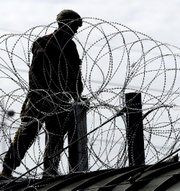WASHINGTON -- Defense Secretary James Mattis has left no doubt that his top priority as leader of the military is making it more "lethal" -- better at war and more prepared for it -- and yet nothing about the military's new mission at the U.S.-Mexico border advances that goal. Some argue it detracts from it.
The troops going to the border areas of Texas, Arizona and California are a small fraction of the military's roughly 1.3 million active-duty members, and the mission is set to last only 45 days. But many question the wisdom of drawing even several thousand away from training for their key purpose: to win wars.
James Stavridis, a retired Navy admiral and former head of the U.S. Southern Command, said the troops should be preparing for combat and other missions, "not monitoring a peaceful border" for the arrival of a migrant caravan of several thousand people on foot, still about 900 miles away.
"It sends a terrible signal to Latin America and the Caribbean as we unnecessarily militarize our border," Stavridis, who also served as the top NATO commander, said Thursday. "It places U.S. troops who are fundamentally untrained for the mission of border security and border enforcement into an area of operations, which could cause incidents of a negative character. If we need more border patrol agents, hire them."
The first 100 or so active-duty troops arrived at the border Thursday, making an initial assessment at the McAllen, Texas, crossing.
Overall, there are about 2,600 troops at staging bases in the region.
David Lapan, a retired Marine colonel who is a former spokesman for the chairman of the Joint Chiefs and the Department of Homeland Security, said that taking troops away from training and from their families to play a supporting role in border security is unwise.
"It just doesn't make any sense," said Lapan, now a vice president of communications at the Bipartisan Policy Center. "This caravan, this group of poor people, including a lot of women and children, doesn't pose a threat -- not a national-security threat."
In line with the Pentagon's national-security strategy, Mattis has been focused on improving the combat readiness of a military worn down by the recent years of congressionally imposed budget cuts and the grind of 17 years of war in Afghanistan.
This includes reorienting training from that required for the smaller wars the U.S. has fought since the Sept. 11 terrorist attacks to a "great power" struggle with Russia and China.
That context may explain why the Pentagon itself seemed caught off-guard by President Donald Trump's abrupt order to dispatch active-duty troops; the Customs and Border Protection, which requested Pentagon help, has struggled to define details of the mission and explain its scope.
"That this is a security threat is preposterous and not supported by the evidence," said Derek Chollet, former senior policy adviser at the Pentagon. "If you're sitting in the Pentagon and worried about implementation of the national defense strategy and worried about the threats from China and Russia, this is not at the top of your list."
"This is another version of the parade," Chollet said, referring to Trump's demand earlier this year -- eventually withdrawn -- that the military spend millions to stage a parade in Washington. "This is not a good use of U.S. military resources at this moment. Trump was frustrated in his effort to build a physical wall on the border, now he's trying to build a human wall by using the U.S. military."
Gen. Terrence O'Shaughnessy, who as head of U.S. Northern Command is commanding the military operation, dubbed Operation Faithful Patriot, has argued that the caravan is a potential threat, although he has not fully defined that.
"I think what we have seen is we've seen clearly an organization at a higher level than we've seen before," O'Shaughnessy said. "We've seen violence coming out of the caravan and we've seen as they've passed other international borders, we've seen them behave in a nature that has not been what we've seen in the past."
The military says it is deploying 7,000 troops to Texas, Arizona and California, and while it has left open the possibility that the number could grow by another 1,000 under current plans, the scope of the mission has grown in recent days. On Wednesday, Trump said he would send as many as 15,000 troops.
Sen. Jack Reed, the ranking Democrat on the Senate Armed Services Committee, said in a letter Thursday to Trump that his administration has given the committee no evidence that migrant caravans pose a direct security threat to the U.S.
"This is not a military problem; it does not warrant a military solution," Reed wrote.
He said the administration should disclose the cost of the military's border mission "and what impacts it will have on military readiness and the overall budget."
RELATED ARTICLE
https://www.arkansa…">Push to stop caravan raises suit
A Section on 11/03/2018

